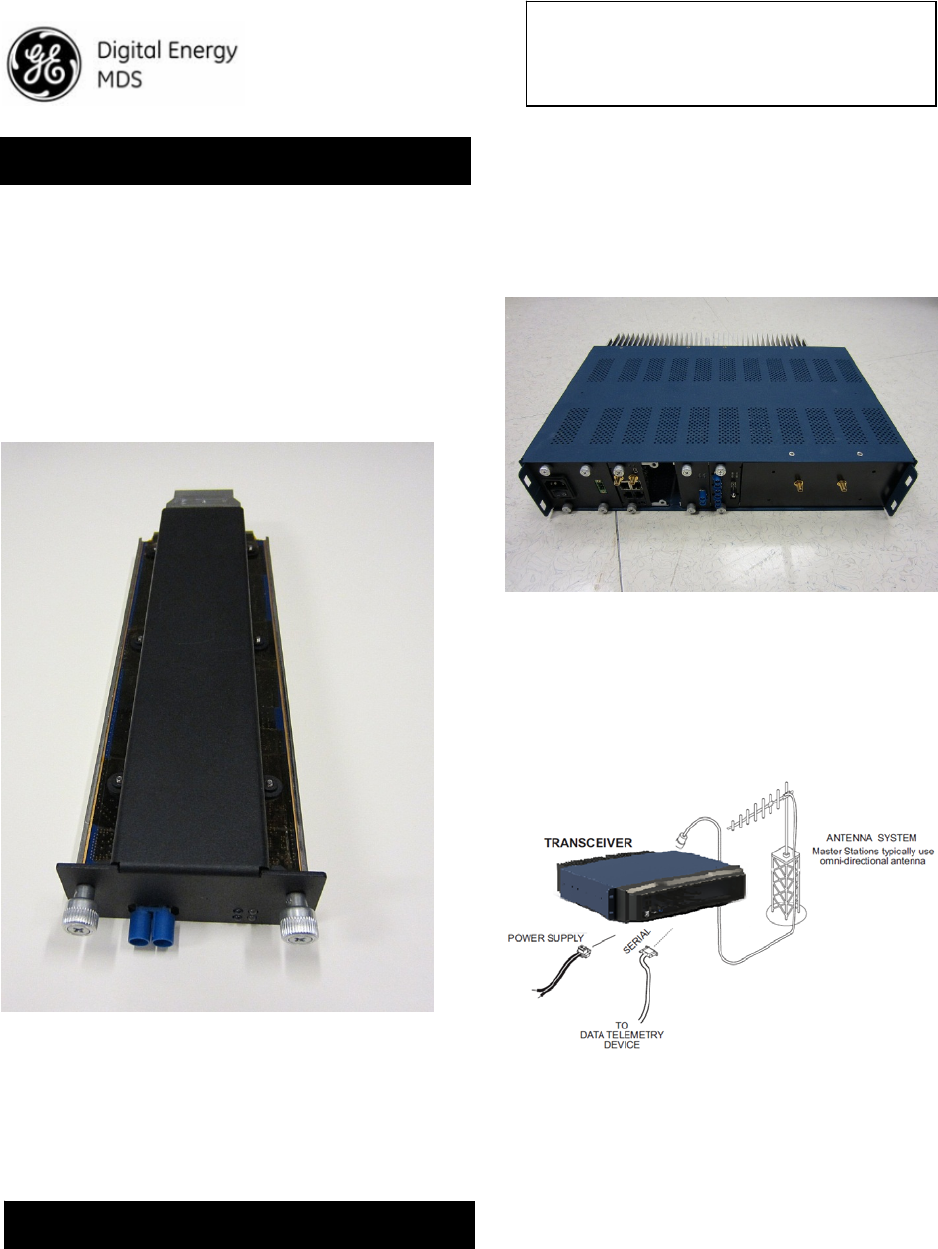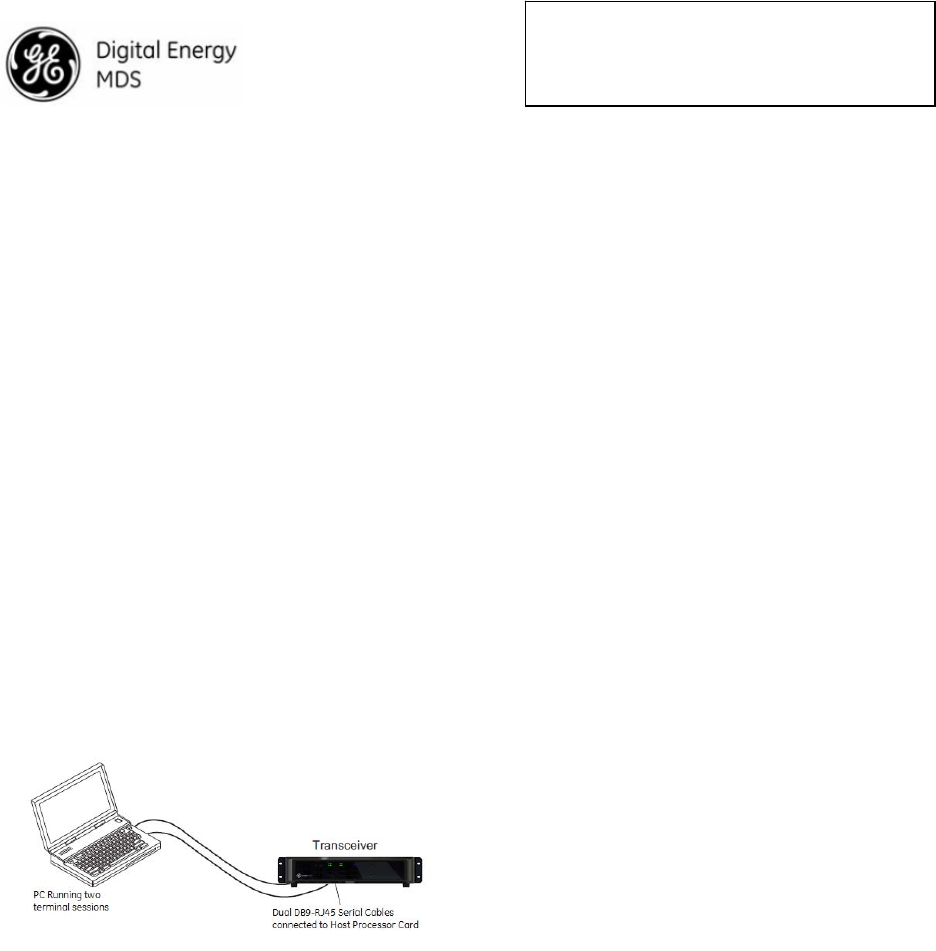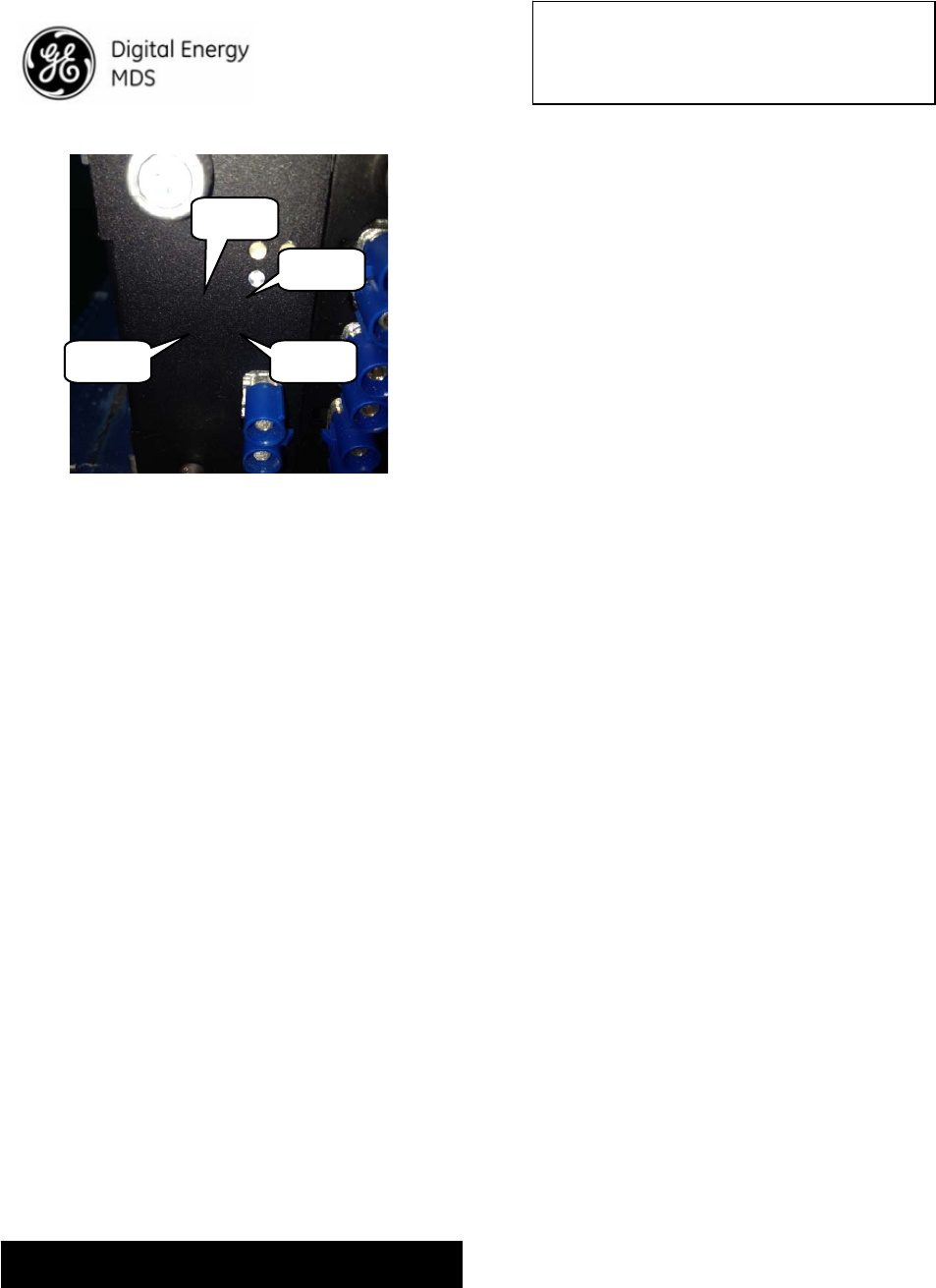GE MDS DS-SDM9 MDS SDM9 Licensed Spectrum Module User Manual SDM9 Operation Manualx
GE MDS LLC MDS SDM9 Licensed Spectrum Module SDM9 Operation Manualx
GE MDS >
User Manual

MDSSDM9
QuickStartGuide(x790Mode)
The MDS SDM9 transceiver (Figure 1) is a software-
configurable, industrial Master Station solution for use
in wireless telemetry applications. In this guide, the
term SD is used for information common to all models
of the radio. This radio module is designed for use
with a card cage and backplane similar to that shown
in Figure 3, and to be used with a variety of data
control equipment such as remote terminal units
(RTUs), programmable logic controllers (PLCs), flow
computers, and similar devices. Data interface
connections may be made by both serial (RS-
232/485) and limited Ethernet protocols.
Invisipbllhaeoc led er
Figure 1. MDS SDM9 Data Transceiver
1.1 About This Guide
This guide covers SDM9 transceivers operating in
x710-Compatible Mode. All GE MDS manuals are
available free of charge at www.gemds.com.
Invisipbllhaeoc led er
There are three main requirements for installing the
transceiver:
• Adequate and stable primary power
• An efficient and properly installed antenna system
• Correct interface connections between the
transceiver and the data device.
Figure 2 shows a chassis with card cage and
backplane that this module would be typically installed
in. The backplane provides the 24V power
connection to this unit and provides the customer data
interfaces through the card edge connector on the
rear of the SDM9.
Figure 2: Typical Orbit Master Station Chassis.
The SDM9 modules may be installed in any free
peripheral slot of this chassis.
Figure 3 shows a typical installation of the radio.
NOTE: Retrofit Kits are available to simplify
installation at former MDS x710 digital and analog
sites. Consult the Reference Manual for ordering
details.
Figure 3: Typical Master Station Chassis with
SDM9 radio card installed. NOTE: Chassis has
antenna connection in rear, with power and data
connections in the front.
2.1 Installation Steps
1. Install the transceiver into chassis as shown in
Figure 2.
NOTE: To prevent damage to the SDM9 radio, wear a
wrist strap to prevent ESD discharge to the card edge
connector. Also, dress all cables as required to
prevent moisture from running along the cables and
into the radio.
1.0 INTRODUCTION
2.0 INSTALLATION

MDSSDM9
QuickStartGuide(x790Mode)
2. Install the antenna and feedline. The antenna
used with the radio must be designed to operate in
the radio’s frequency band, and be mounted in a
location providing a clear path to the associated
station(s). At Remote sites, aim directional antennas
toward the Master Station. Low loss coaxial feedline
should be used and it should be kept as short as
possible.
3. Connect the data equipment. Connection may be
made to the COM port using Serial protocols (RS-
232/RS-485). RJ45 to DB9/DB25 adapters may be
required depending on physical data port connector
type used on the data telemetry device to be attached
as shown in Figure 3.
4. Connect primary power to the Orbit Chassis.
Input power must within the ranges specified for the
power supply module installed in the Orbit chassis:
12VDC, 24VDC, 48VDC, 125VDC, or 90-264VAC.
These supplies all convert incoming power to +24V
for SDM9 Module operation.
5. Set the radio’s configuration. Connect a PC to
the radio’s COM1 and COM2 ports as shown in
Figure 4. A straight-thru cable may be used for this
connection with an RJ45 to DB9 adapter. NOTE:
Consult your System Administrator if you are unsure
of the settings required for your network.
Figure 4. Setup for PC Configuration
2.1.1 Software Configuration
There are two methods for communicating with the
radio for configuration and management: Serial
(COM1, COM2 RJ45 connector) and Telnet
(ETHERNET RJ-45 connector). Both present identical
functionality and use the same commands, but the
method to configure access is different for each.
NOTE: Transmitter and Receiver configuration are
handled through separate DSP devices, thus two
serial ports or two Telnet sessions will be required to
handle configuration of these two functions.
The focus here is on Serial access, but Telnet may be
used by following these additional points, which
replace Steps 1 and 2 below:
• For Telnet, connect to the radio with a PC
that is on the same IP network as the
transceiver. Launch a Telnet program, and
connect to the radio using its programmed IP
address for the Transmitter and Receiver.
• The default IP address of the Transmitter
configuration is 192.168.1.1. The default IP
address of the Receiver configuration is
192.168.1.2. If you do not know the IP
address of the radio, use the serial
configuration steps below to view the
address with the IPCONFIG command.
1. With a PC connected to the COM1 serial port,
launch a terminal program, such as HyperTerminal
(included withmost pre-Windows7
®
-based PCs) and
set the following parameters: 8 bits, no parity, one
stop bit (8N1), flow control disabled, VT100
emulation. The COM port automatically finds the
connected baud rate (within 1200–115200 bps).
2. Press the ESCAPE key followed by a series of
ENTER keypresses (at 1/2 second intervals) until the
> prompt appears. The radio is now ready to accept
commands.
3. Set/verify the RX (receive) and TX (transmit)
frequencies. To set the receive frequency, enter RX
followed by the correct frequency in MHz
(xxx.xxxxx). Press ENTER . To set the transmit
frequency, enter TX followed by the correct frequency
in MHz (xxx.xxxxx). Press ENTER.
4. The factory default modem settings support 9600
bps transmission in a 12.5 kHz bandwidth channel.
Many other options are available. The current setting
may be viewed using the MODEM command. Use
MODEM [xxxx] if changes are required.
When finished with the steps above, review the other
configuration options to determine if other settings are
required for your system. Table 3 lists key software
commands for the radio.
2.2 Initial Checkout
In-service operation is completely automatic. The only
operator actions required are to apply DC power and
observe the LEDS for proper indications. Table 1 on
the following page summarizes the radio’s LED
functions.

MDSSDM9
QuickStartGuide(x790Mode)
2.2.1 LED Functions
Figure 5. LED Status Indicators
Table 1: Description of LED Status Indicators
POWER: Green Continuous—Power applied, no problems
detected.
ALARM: Red Flashing (5x-per-second) Alarm Indication
ACTIVE: Blue Continuous – Transceiver is operational
TX: Blue Flashing/Continuous – This LED illuminates
whenever the transmitter is active
2.2.2 Antenna SWR Check
Before placing the unit in final operation, the antenna
system’s standing wave ratio (SWR) should be
checked using a wattmeter suited to the frequency of
operation. High SWR (above 2:1) may indicate an
antenna or feedline problem, and should be
corrected.
2.2.3 RSSI Check (for SD Remotes)
Use the RSSI command (received signal strength
indication), command to check for adequate signal
strength. The radio must be receiving a signal from
the associated Master Station (LINK LED on or
blinking). In general, signal levels stronger than –80
dBm will provide reliable communication and allow for
a degree of “fade margin.” Optimize the RSSI at
Remotes by slowly adjusting the direction of the
station antenna. Watch the RSSI indication for several
seconds after making each adjustment so that the
RSSI accurately reflects any change in signal
strength. With RSSI reading, the less negative the
number, the stronger the incoming signal (i.e., -70
dBm is stronger than -80 dBm).
All radios in the network must meet the following
requirements for proper operation. Check these items
first when troubleshooting a communication problem:
• Adequate and stable primary power
• Secure cable connections (RF, data and power)
• A clear transmission path between Master and each
Remote
• An efficient and properly aligned antenna system
providing adequate received signal strength.
• Proper programming of the transceiver’s parameters
• The correct interface between the transceiver and
the connected data equipment (correct cable wiring,
proper data format, timing, etc.)
3.1 LEDs
The radio’s LED indicator panel provides useful
information when troubleshooting a system problem.
Refer to Table 1 for LED information.
3.2 Event Codes
When an alarm condition exists, the transceiver
creates a message that can be read on a connected
PC by using the ALARM command. Consult the SD
Reference Manual for further details.
3.2.1 Types of Alarms
Minor Alarms—report conditions that, under most
circumstances, will not prevent transceiver operation.
These include out-of-tolerance conditions, baud rate
mismatches,etc. The cause of these alarms should be
investigated and corrected to prevent system failure.
Major Alarms—report serious conditions that
generally indicate a hardware failure, or other
abnormal condition that will prevent (or hamper)
further operation of the transceiver. Major alarms may
require factory repair. Contact your factory
representative for assistance.
Power
Alarm
TXActive
3.0 TROUBLESHOOTING

MDSSDM9
QuickStartGuide(x790Mode)
Table 3 lists key software commands for the transceiver.
Detailed descriptions are provided in the SD Reference
Manual. Commands can typically be used in two ways:
1. The basic command (shown first) may be entered alone to
issue a query or execute a simple command.
2. The basic command may be appended with additional
arguments (shown in brackets, if applicable) to further define
a setting.
RF Exposure Notice
The radio equipment described in this guide emits radio
frequency energy. Although the power level is low, the
concentrated energy from a directional antenna may pose a
health hazard. Do not allow people to come closer than 1.50
meters to the front of the antenna when the transmitter is
operating with a 7 dBd (9.15 dBi) gain antenna. Use of
higher gain antennas means increasing the distance
accordingly.
FCC Part 15 Notice
Operation of this device subject to the following two
conditions:
(1) this device may not cause harmful interference,
and
(2) (2) this device must accept any interference
received, including interference that may cause
undesired operation. Any unauthorized
modification or changes to this device without the
express approval of the manufacturer may void
the user’s authority to operate this device.
Furthermore, this device is intended to be used
only when installed in accordance with the
instructions outlined in this guide. Failure to
comply with these instructions may void the user’s
authority to operate this device.
Table 3: Key Software Commands
Command Function
ALARM Read current operating condition of the radio.
BAUD [xxxxx abc] Set/display the data rate and control
bits.
BUFF [ON, OFF] Enables or disables the internal radio data
buffer.
CTS [0-255] Set/display the Clear-to-Send delay in
seconds.
DEV Display modem control deviation.
DEVICE [DCE, CTS KEY] Set/display device mode.
DKEY Dekey the radio (transmitter OFF). This is generally
used as a radio test command.
DUMP Display all programmable settings.
HELP Shows available commands.
KEY Key the radio (transmitter ON). This is
generally used as a radio test command.
MODEM [xxxx] Set the modem characteristics of the radio.
PORT [RS232, RS485] Set/display COM2 data port
interface settings.
PTT [0-255] Set/display the Push-to-Talk delay in
milliseconds.
PWR [20-40] Set/display the transmit power setting.
RSSI Display the Received Signal Strength
Indication.
RTU [ON/OFF/0-80] Re-enables or disables the radio’s
internal RTU simulator and sets the RTU address.
RX [xxx.xxxx] Set/display the receive frequency.
RXLEVEL [-20 to 0] Set/display the receive audio input
level.
SCD [0-255] Set/display the Soft-Carrier Dekey delay in
milliseconds.
SHOW [DC, PWR] Display the DC voltages and transmit
power level.
SNR Signal-to-Noise Ratio, expressed in dB
SPECTRUM [xxx.xx] Display the transceiver’s built-in
spectrum analyzer, where xxx.xx denotes center
frequency.
STAT Display radio status and alarms.
TEMP Display the internal temperature of the radio
in degrees C.
TOT [1-255, ON, OFF] Set/display the Time-out Timer delay
in
seconds.
TX [xxx.xxxx] Set/display the transmit frequency.
TXLEVEL [-20 to 0, AUTO] Set/display the transmit audio
input level.
UNIT [10000...65000] Set/display the transceiver’s unit
address.
4.0 COMMAND OVERVIEW